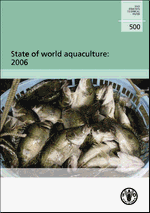State of world aquaculture: 2006 - By the Inland Water Resources and Aquaculture Service, Fishery Resources Division, Fisheries Department, FAO. Aquaculture is developing, expanding and intensifying in almost all regions of the world,
except in sub-Saharan Africa.
Aquaculture is developing, expanding and intensifying in almost all regions of the world,
except in sub-Saharan Africa.
Global population demand for aquatic food products is increasing, the production from capture fisheries has levelled off, and most of the main fishing areas have reached their maximum potential. Sustaining fish supplies from capture fisheries will, therefore, not be able to meet the growing global demand for aquatic food.
Aquaculture appears to have the potential to make a significant contribution to this increasing demand for aquatic food in most regions of the world; however, in order to achieve this, the sector (and aquafarmers) will face significant challenges.
The key development trends indicate that the sector continues to intensify and diversify and is continuing to use new species and modifying its systems and practices. Markets, trade and consumption preferences strongly influence the growth of the sector, with clear demands for production of safe and quality products. As a consequence, increasing emphasis is placed on enhanced enforcement of regulation and better governance of the sector. It is increasingly realized that this cannot be achieved without the participation of the producers in decision-making and regulation process, which has led to efforts to empower farmers and their associations and move towards increasing self-regulation.
These factors are all contributing to improve management of the sector, typically through promotion of better management practices of producers.
This document analyses the past trends that have led the aquaculture sector to its current status and describes its current status globally.
 Aquaculture is developing, expanding and intensifying in almost all regions of the world,
except in sub-Saharan Africa.
Aquaculture is developing, expanding and intensifying in almost all regions of the world,
except in sub-Saharan Africa.
Global population demand for aquatic food products is increasing, the production from capture fisheries has levelled off, and most of the main fishing areas have reached their maximum potential. Sustaining fish supplies from capture fisheries will, therefore, not be able to meet the growing global demand for aquatic food.
Aquaculture appears to have the potential to make a significant contribution to this increasing demand for aquatic food in most regions of the world; however, in order to achieve this, the sector (and aquafarmers) will face significant challenges.
The key development trends indicate that the sector continues to intensify and diversify and is continuing to use new species and modifying its systems and practices. Markets, trade and consumption preferences strongly influence the growth of the sector, with clear demands for production of safe and quality products. As a consequence, increasing emphasis is placed on enhanced enforcement of regulation and better governance of the sector. It is increasingly realized that this cannot be achieved without the participation of the producers in decision-making and regulation process, which has led to efforts to empower farmers and their associations and move towards increasing self-regulation.
These factors are all contributing to improve management of the sector, typically through promotion of better management practices of producers.
This document analyses the past trends that have led the aquaculture sector to its current status and describes its current status globally.
Read the report
Download: State of world aquaculture: 2006 (145 page PDF)
Source: Inland Water Resources and Aquaculture Service, Fishery Resources Division,
Fisheries Department, FAO.

